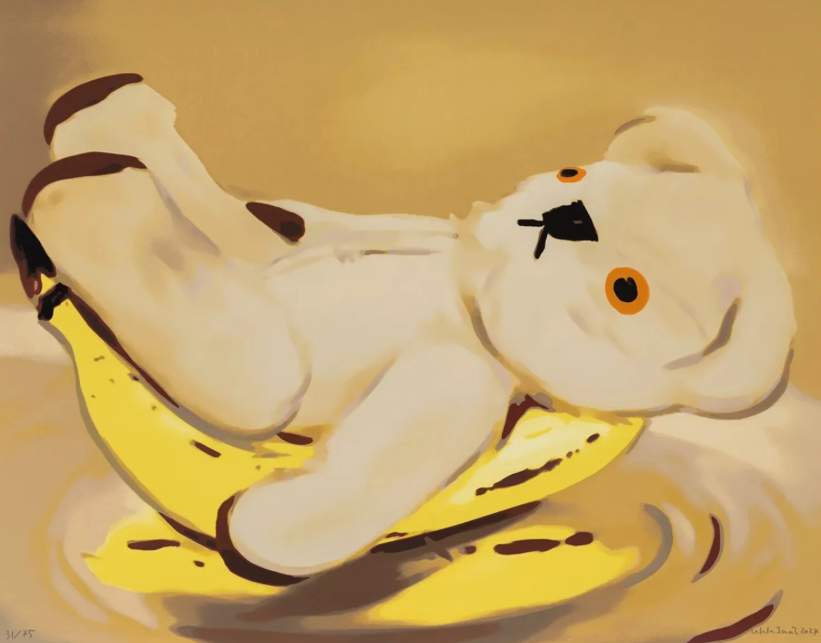In an age of speed, spectacle, and streaming pixels, Japanese artist Ulala Imai offers a rare kind of visual resistance — a painterly meditation where objects hum instead of shout, and silence is a syntax all its own. Her 2024 screenprint, Melody, exemplifies this ethos. Executed as a 21-color screenprint on Somerset Satin White 300gsm paper, the work belongs to a growing movement of artists who blend the fine lines of classical interiority with contemporary surrealism, creating what might be called a new grammar of emotional stillness.
While Melody shares formal similarities with Imai’s previous oil works — a domestic quietude, figural detachment, and pastel surrealism — this screenprint functions as a portal into her evolving visual language. What unfolds in this edition is more than a collectible artwork. It is a study in surface, memory, and the ineffable currents that run beneath daily life. Rendered with surgical layering and exquisite restraint, Melody breathes with its own internal rhythm: part lullaby, part reverie, part cipher.
The Artist and Her Vocabulary of the Everyday
Born in 1982 in Kanagawa, Japan, Ulala Imai has become an unexpected voice of softness in a cultural moment dominated by technological obsession and algorithmic speed. Her practice — rooted in oil painting but increasingly traversing print and installation — eschews overt narrative in favor of impressionistic intimacy. The familiar forms in Imai’s world are not always legible in a Western figurative sense. Dolls, chairs, fruit, plastic animals, blankets — all inhabit her canvases like ghosts of remembered rooms.
These domestic ephemera, often portrayed with a dreamy matter-of-factness, give her works the uncanny impression of being both documentary and dreamscape. With Imai, there is no spectacle in the usual sense. Rather, there is atmosphere as anchor — and in Melody, the atmosphere expands in 21 shades, meticulously applied through screenprinting, each hue a compositional heartbeat.
Unlike her larger oils, which carry the textured seduction of brushstroke and impasto, Melody leverages the discipline of printmaking to flatten and sharpen. The result is not a loss of depth, but a conversion of tactile warmth into optical harmony. Printed on Somerset Satin White 300gsm paper — a heavyweight, archival-grade substrate favored for its stability and refined tooth — the work pulses quietly with controlled softness. The paper does not simply hold the image; it becomes its atmospheric bed.
Inside Melody: A Dream in 21 Layers
At first glance, Melody seems almost resistant to interpretation. Its hues feel lifted from a child’s pastel crayon box — soft rose, muted periwinkle, washed-out ochre — but the arrangement is far too deliberate to be naive. Central to the composition is a lone figure, not quite human and not quite doll, nestled amid a collection of domestic fragments. There is a toy piano, or what resembles one, half-emerging from the visual background. Around it, small inanimate companions: a plush creature, a hand mirror, a ceramic bowl, perhaps a folded cloth.
What binds these objects together is neither hierarchy nor spatial logic, but a poetic one — a sense that each object “knows” the other through association, not function. The titular Melody may refer to the piano, but it also refers to the entire composition’s sonic-like rhythm. Imai arranges colors and forms the way a composer arranges notes: not for meaning, but for resonance.
Each of the 21 screenprint layers is visible upon close inspection, not in sharp relief but in tone relationships. One can detect the careful sequencing of overlaid inks — a blush on top of white, a gray on top of lavender — creating shadow and light not through value alone but through transparency and interaction. The print process becomes a choreography of patience, where each successive color must align perfectly to maintain visual equilibrium.
This tension — between the rigid technicality of screenprinting and the emotional fluidity of the image — is the soul of Melody. It reads almost like a lullaby in visual form, not only in color but in structure. There is no crescendo, no disruption, only the rhythmic repetition of shapes and soft contrasts. Like the best music, its emotion lies in the intervals between.
Context and Continuity in Imai’s Oeuvre
To view Melody in isolation would be to misunderstand its role in Imai’s practice. While it stands beautifully alone, it also operates as a satellite in a larger orbit of works. Throughout the last decade, Imai has consistently returned to themes of stillness, domesticity, and ambiguity, often using dolls and toys as placeholders for emotional avatars. But unlike the dead-eyed stare of contemporary pop surrealism, her subjects possess an inner life that resists pathologizing.
Her work has often been compared to artists like Yasuyo Morimoto, Chantal Joffe, and even Giorgio Morandi, but where Morandi reduces the domestic to form, and Joffe inflates the figure, Imai walks a more interior path. Her prints and paintings often feel like recollections filtered through gauze — not memories per se, but the feeling of remembering.
In that sense, Melody is a deeply psychological work. It may look visually placid, but its emotional palette is dense. There is nostalgia here, yes, but also longing. There is childlike wonder, but also an adult’s grief. There is quiet, but not silence. Just as a melody requires intervals to exist — rests between notes — Imai uses absence as presence. The empty spaces in Melody are not voids; they are rooms where emotion waits, silently.
Cultural Reverberations: Slowness in the Speed Era
The release of Melody as a print in 2024 also speaks to broader currents in both the art world and the cultural psyche. As attention spans shorten and digital overexposure becomes the norm, artists like Ulala Imai represent a countermovement — one that values slowness, repetition, materiality, and the hand-made.
Printmaking, particularly the multi-layered screen process employed here, becomes a radical act of labor in an era of digital auto-generation. Each layer is a decision. Each pass of the squeegee is a risk. In contrast to the instantaneity of NFTs or algorithmic art, a screenprint like Melody asks the viewer to slow down, to take in 21 levels of subtlety. It rewards attention, not reaction.
That this work is made in Japan, a country with a profound history of print — from ukiyo-e woodblocks to contemporary editions — situates it within a lineage that is both national and transhistorical. But Imai’s print is not an homage. It is a soft rebellion — a private, emotional image in a world of public declarations.
Collectibility and Material Permanence
For collectors and curators alike, Melody holds a particular kind of allure. It is not simply a beautiful object, but a technically masterful and emotionally layered work. Printed on Somerset Satin White 300gsm paper, it guarantees not only visual fidelity but archival longevity. The use of 21 individual colors in the screenprint also pushes the boundaries of typical edition practices, making it a rarity even among serious printmakers.
But what sets it apart isn’t just craftsmanship. It’s the ineffable quality that so many of Imai’s works hold: an invitation to feel, not just to look. A print like Melody becomes not just wall décor or a financial asset, but a companion — something that continues to change depending on the emotional light in which it is viewed.
The Emotional Topography of Melody
In Melody, Ulala Imai has created more than a screenprint — she has composed a visual sonata in pastel and shadow. The work’s surface belies its depth, its sweetness disguises its structural complexity, and its silence pulses with metaphor. It is a reminder that the quietest images often carry the most enduring emotional vibrations.
As the world spins faster and louder, Imai’s Melody offers a different rhythm: one of reflection, interiority, and subtle courage. It doesn’t ask for your applause. It asks for your attention. And if you listen carefully — beneath the layers of ink, beneath the quiet pinks and translucent grays — you might just hear it sing.
No comments yet.








